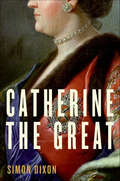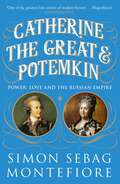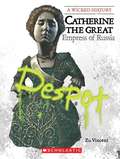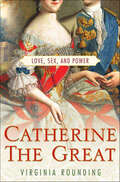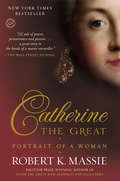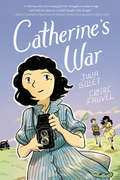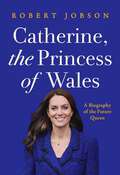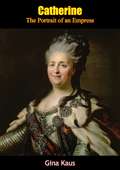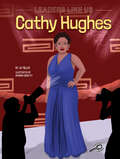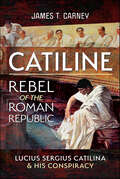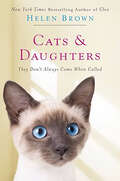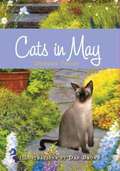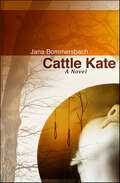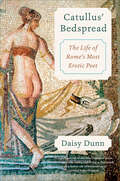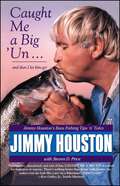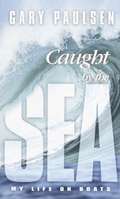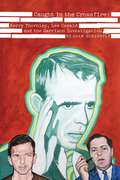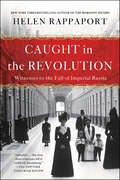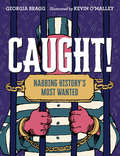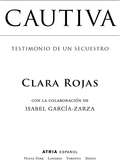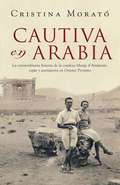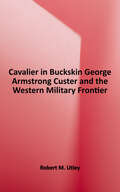- Table View
- List View
Catherine the Great (Profiles In Power Ser.)
by Simon Dixon“[A] superb biography….Scholarly, refreshing, commonsensical, and compelling, vividly portraying the charismatic Empress and her times.”—Simon Sebag Montefiore, author of SashenkaSimon Dixon’s Catherine the Great is a complete and revealing portrait of an extraordinary leader, chronicling her rise to power and her remarkable reign as empress of Russia. Catherine Merridale, author of Ivan’s War, calls this definitive history, “attractive, engaging, and very intelligent….Established fans of the Russian empress will find plenty of new material and those who are meeting her for the first time will be dazzled.”
Catherine the Great and Potemkin: The Imperial Love Affair
by Simon Sebag Montefiore'One of the great love stories of history, in a league with Napoleon and Josephine, and Antony and Cleopatra ... Excellent, with dazzling mastery of detail and literary flair' EconomistIt was history's most successful political partnership - as sensual and fiery as it was creative and visionary. Catherine the Great was a woman of notorious passion and imperial ambition. Prince Potemkin - wildly flamboyant and sublimely talented - was the love of her life and her co-ruler.Together they seized Ukraine and Crimea, defining the Russian empire to this day. Their affair was so tumultuous that they negotiated an arrangement to share power, leaving Potemkin free to love his beautiful nieces, and Catherine her young male favourites. But these 'twin souls' never stopped loving each other.Drawing on their intimate letters and vast research, Simon Sebag Montefiore's enthralling, widely acclaimed biography restores these imperial partners to their rightful place as titans of their age.
Catherine the Great and Potemkin: The Imperial Love Affair
by Simon Sebag Montefiore'One of the great love stories of history, in a league with Napoleon and Josephine, and Antony and Cleopatra ... Excellent, with dazzling mastery of detail and literary flair' EconomistIt was history's most successful political partnership - as sensual and fiery as it was creative and visionary. Catherine the Great was a woman of notorious passion and imperial ambition. Prince Potemkin - wildly flamboyant and sublimely talented - was the love of her life and her co-ruler.Together they seized Ukraine and Crimea, defining the Russian empire to this day. Their affair was so tumultuous that they negotiated an arrangement to share power, leaving Potemkin free to love his beautiful nieces, and Catherine her young male favourites. But these 'twin souls' never stopped loving each other.Drawing on their intimate letters and vast research, Simon Sebag Montefiore's enthralling, widely acclaimed biography restores these imperial partners to their rightful place as titans of their age.
Catherine the Great: Empress of Russia
by Zu VincentBiography of Catherine the Great of Russia. During her 34-year reign, Catherine expanded the borders of Russia and earned the respect of the rest of Europe.
Catherine the Great: Love, Sex, and Power
by Virginia RoundingDutiful daughter, frustrated wife, passionate lover, domineering mother, doting grandmother, devoted friend, tireless legislator, generous patron of artists and philosophers—the Empress Catherine II, the Great, was all these things, and more. Her reign, the longest in Russian Imperial history, lasted from 1762 until her death in 1796; during those years she built on the work begun by her most famous predecessor, Peter the Great, to establish Russia as a major European power and to transform its new capital, St Petersburg, into a city to rival Paris and London in the beauty of its architecture, the glittering splendor of its Court and the magnificence of its art collections. Yet the great Catherine was not even Russian by birth and had no legitimate claim to the Russian throne; she seized it and held on to it, through wars, rebellions and plagues, by the force of her personality, by her charm and determination, and by an unshakable belief in her own destiny.This is the story of Catherine the woman, whom power alone could never satisfy, for she also wanted love, affection, friendship and humor. She found these in letter-writing, in grandchildren, in gardens, architecture and greyhounds—as well as in a succession of lovers which gave rise to salacious rumors throughout Europe. The real Catherine, however, was more interesting than any rumor.Using many of Catherine's own words from her voluminous correspondence and other documents, as well as contemporary accounts by courtiers, ambassadors and foreign visitors, Virginia Rounding penetrates the character of this most powerful, fascinating and surprisingly sympathetic of eighteenth-century women.
Catherine the Great: Portrait Of A Woman (Great Lives Ser.)
by Robert K. Massie“[A] tale of power, perseverance and passion . . . a great story in the hands of a master storyteller.”—The Wall Street Journal The Pulitzer Prize–winning author of Peter the Great, Nicholas and Alexandra, and The Romanovs returns with another masterpiece of narrative biography, the extraordinary story of an obscure German princess who became one of the most remarkable, powerful, and captivating women in history. Born into a minor noble family, Catherine transformed herself into empress of Russia by sheer determination. For thirty-four years, the government, foreign policy, cultural development, and welfare of the Russian people were in her hands. She dealt with domestic rebellion, foreign wars, and the tidal wave of political change and violence churned up by the French Revolution. Catherine’s family, friends, ministers, generals, lovers, and enemies—all are here, vividly brought to life. History offers few stories richer than that of Catherine the Great. In this book, an eternally fascinating woman is returned to life. “[A] compelling portrait not just of a Russian titan, but also of a flesh-and-blood woman.”—Newsweek “An absorbing, satisfying biography.”—Los Angeles Times “Juicy and suspenseful.”—The New York Times Book Review “A great life, indeed, and irresistibly told.”—Salon NAMED ONE OF THE BEST BOOKS OF THE YEAR BY The New York Times • The Washington Post • USA Today • The Boston Globe • San Francisco Chronicle • Chicago Tribune • Newsweek/The Daily Beast • Salon • Vogue • St. Louis Post-Dispatch • The Providence Journal • Washington Examiner • South Florida Sun-Sentinel • BookPage • Bookreporter • Publishers Weekly BONUS: This edition contains a Catherine the Great reader's guide.
Catherine's War
by Julia Billet“A shining story of a young girl who struggles to come of age and find her place in a world fraught with danger.” —Susan Campbell Bartoletti, Newbery Honor-winning author of Hitler Youth* Winner of the Youth Prize at the Angoulême International Comics Festival (voted by readers) * Winner of the Artémisia Prize for Historical Fiction * Winner of the Andersen Premio Prize *A magnificent narrative inspired by a true survival story that asks universal questions about a young girl’s coming of age story, her identity, her passions, and her first loves.At the Sèvres Children’s Home outside Paris, Rachel Cohen has discovered her passion—photography. Although she hasn’t heard from her parents in months, she loves the people at her school, adores capturing what she sees in pictures, and tries not to worry too much about Hitler’s war. But as France buckles under the Nazi regime, danger closes in, and Rachel must change her name and go into hiding.As Catherine Colin, Rachel Cohen is faced with leaving the Sèvres Home—and the friends she made there—behind. But with her beautiful camera, Catherine possesses an object with the power to remember. For the rest of the war, Catherine bears witness to her own journey, and to the countless heroes whose courage and generosity saved the lives of many, including her own.Based on the author’s mother’s own experiences as a hidden child in France during World War II, Catherine’s War is one of the most accessible historical graphic novels featuring a powerful girl since Persepolis by Marjane Satrapi—perfect for fans of Markus Zusak’s The Book Thief, Anne Frank, or Helen Keller.Includes a map and photographs of the real Catherine and her wartime experiences, as well as an interview with author Julia Billet.“Many of the settings are beautifully detailed, and the characters undeniably expressive. Catherine’s ability to find beauty in the world makes for a forward-looking read.” —Booklist *(starred review)*“This story will make readers want to join the Resistance. Characters are drawn so vividly that, long afterward, readers will remember their names.” —KirkusAn Indie Next List Pick!*A Junior Library Guild selection*
Catherine, the Princess of Wales: A Biography of the Future Queen
by Robert JobsonThrough the author&’s extensive connections within the royal household, this dynamic new biography tells the full story of how Catherine, the Princess of Wales, became the woman she is today.Kate Middleton's life's story seems like a modern-day fairy-tale. An attractive, clever, and ambitious girl from unexceptional beginnings meets and falls in love with a wealthy prince when they are both college undergraduates. Now, with the British monarchy in transition, Catherine is destined to become the first "commoner Queen&” in British history since Anne Hyde, wife of James II. Since her wedding on April 29th, 2011—and since becoming the Duchess of Cambridge—Catherine has endeared herself to the people of the Britain and America with her extensive travels, with her infectious smile, sense of style, and down-to-earth nature. With her self-deprecation, willingness to laugh at herself, solid work-ethic—along with William&’s warmth, and accessibility—this dynamic duo has become the most popular members of the royal family. As interest in the royals continues to gain legions of new, younger fans, there is increasing interest in the histories and back stories of the principal players in this story. Through the author&’s connection with sources both on and off the record within the royal household, this dynamic new biography tells the full story of how Catherine became the woman she is today.
Catherine: The Portrait of an Empress
by Gina KausTHERE have been better women than Catherine of Russia, nobler and more learned women, but history discloses no woman who combined so much of good and evil into one bewildering and gloriously successful career. Daughter of a petty German Prince, chance made her the wife of the heir to the Russian Empire. She took that nation to her heart, discarded her weakling husband, and ruled her adopted country for more than three decades with a strength and understanding it had seldom known before.No one rejoiced at the birth of Catherine. Her parents had prayed for a boy, and the little girl was soon made to feel the bitterness of their disappointment. She decided, therefore, to become a man and, when the opportunity appeared, she decide to become the greatest man in Europe. Nothing stood in the way of that determination—Catherine was quite prepared to commit murder when the occasion called for it—but she was not cruel according to the standards of her day. She was kind, open-handed; her sympathetic interest in her people was deep; and she became noted for her acts of spontaneous generosity.Gina Kaus seizes the material which this unique life affords, remolds it in the light of newly discovered documents and modern psychology, and presents for the first time a unified and congruous portrait of Catherine. The spectacular occurrences of the Empress’s reign appear here in their relative significance to her life and to European history. Catherine fulfilled the dream of her girlhood and, as Frau Kaus remarks, she died the happiest death that ever Tsar died—she died of laughter.
Cathy Hughes (Leaders Like Us #11)
by J. P. MillerChildren learn about one of the most influential African American leaders in history with the biography of media titan Cathy Hughes.By founding Radio One-Urban One, Cathy Hughes became one of the most powerful African American media figures in history. Creating a source of accurate news and entertainment for African Americans, Cathy Hughes changed the media landscape for years to come.Storybook Features:This children’s book features a glossary with new vocabulary, text-dependent questions, and an extension activity to develop reading comprehension skills.24 pages of vibrant illustrationsLexile 290LAbout RourkeWe proudly publish respectful and relevant non-fiction and fiction titles that represent our diverse readers, and are designed to support reading on a level that has no limits!
Catiline, Rebel of the Roman Republic: Lucius Sergius Catilina & His Conspiracy
by James T. CarneyThis is the only modern, scholarly biography of Catiline, based on an exhaustive study of the ancient sources and modern scholarship. Lucius Sergius Catilina ('Catiline'), was a Roman aristocrat from a poor but noble family. He was controversial figure both in his own times and in subsequent historical scholarship. Catiline was cast first as the Roman equivalent of Richard III and later as a left-wing revolutionary, depending on the times and historians’ leanings. Although Catiline’s calls for debt relief and other measures in his second consular campaign earned him support from the poor, the author finds that Catiline was motivated by pride and ambition rather than by an interest in widespread social and economic reforms. Embittered by his failure to attain the consulship which he thought was his due given his heritage. He had his lieutenant Manlius raise armed forces in Etruria while he planned to stage a coup in Rome when these forces approached the city. The conspiracy was betrayed to Cicero. Cicero skillfully used his knowledge of the conspiracy to force Catiline to leave Rome and join Manlius, leaving the city conspirators without effective leadership. Catiline’s urban lieutenants soon blundered by seeking to enlist the support of a Gallic tribe whose emissaries were in the city. The Gauls, skeptical of the conspirators; leadership. decided report all that they had learned about the conspirators’ plans to Cicero. Using the evidence obtained from the Gauls, Cicero presented a prosecutor’s case against the conspirators to the Senate and rallied public opinion against the Catilinarians. Cicero then executed five of the key conspirators without trial. When Catiline’s soldiers learned of destruction of the urban conspiracy, many deserted. Cataline, finding his army trapped between two larger government forces, died fighting in a fierce but doomed battle at Pistoia.
Cats & Daughters: They Don't Always Come When Called
by Helen BrownSome say your previous cat chooses your new feline. If so, what in cat heaven's name was our beloved Cleo thinking when she sent us a crazy cat like Jonah?Helen Brown swore she'd never get another cat after her precious Cleo died. But that was before a cute Siamese with an intense blue gaze wrapped her around his paw. Demonstrating the grace of a trapeze artist--and a talent for smashing anything breakable--Jonah seduced the household with his daredevil antics and heart-melting purr. With her son getting married, her daughter setting off on a potentially dangerous personal quest, and a recent brush with her own mortality, Helen faced a whirlwind of joys and challenges. Yet Jonah proved just the thing to ease the busy household's growing pains. Uplifting, witty, and wise, here is a story of love and family--four-legged members included. Don't Miss Helen Brown's Beloved Bestseller, Cleo"A buoyant tale, heartfelt and open." --Booklist"An absolute must." --Cat World"Even non-cat-lovers will be moved." --Good Housekeeping
Cats in May
by Doreen ToveyThe Toveys attempt to settle down to quiet life in the country. Unfortunately, their tyrannical Siamese cats have other ideas. From causing an uproar on the BBC to claiming to have been kidnapped, Sheba and Solomon's outrageous behavior leaves the Toveys at their wits' end. Meanwhile, Doreen has to contend with her husband's disastrous skills as a handyman, a squirrel that chews the buttons off all his suits, and a runaway tortoise named Tarzan. Both human and animal characters come to life on the page in these witty stories, including Sidney, the problem-prone gardener, and Blondin, the brandy-swilling squirrel. In a new edition, with 20 delightful black and white illustrations, Tovey's tales are ready for rediscovery by a new generation of cat lovers. A truly enjoyable read for anyone who's ever been owned by a cat, it will tickle your funny bone and tug on your heartstrings.
Cattle Kate: A Novel
by Jana Bommersbach"A fascinating and disturbing look at a very dark chapter in the annals of the American West."—C.J. BOX, New York Times bestselling authorCattle Kate is the only woman ever lynched as a cattle rustler. History called it "range land justice" when she was strung up in Wyoming Territory on July 20, 1889, tarring her as a dirty thief and a filthy whore. But history was wrong. It was all a lie.Her real name was Ella Watson. She wasn't a rustler. She wasn't a whore. And she'd never been called Cattle Kate until she was dead and they needed an excuse. She was really a 29-year-old immigrant homesteader, lynched with her husband by her rich and powerful cattle-baron neighbors who wanted her land and its precious water rights.Some people knew the truth from the start. Their voices were drowned out by the all-powerful Wyoming Stock Growers Association. And those who dared speak out—including the eyewitnesses to the hangings—either disappeared or mysteriously died. There was no one left to testify against the vigilantes when the case eventually came to trial. Her six killers walked away scot-free. But the legend was stronger than the truth. For over a century, newspapers, magazines, books—movies, too—spread her ugly legacy.Now, on the 125th anniversary of her murder, the real Ella comes alive in Cattle Kate to tell her heartbreaking story. Jana Bommersbach's debut novel bares a legend central to the western experience.
Catullus' Bedspread: The Life of Rome's Most Erotic Poet
by Daisy Dunn“A superb portrait of this most human of poets who leaps to life, hating and loving as ferociously as ever, before our twenty-first-century eyes.” —The Sunday Times (London)A vivid narrative that recreates the life of Gaius Valerius Catullus, Rome’s first modern poet, and follows a young man’s journey through a world filled with all the indulgences and sexual excesses of the time, from doomed love affairs to shrewd political maneuvering and backstabbing—an accessible, appealing look at one of history’s greatest poets.Born to one of Verona’s leading families, Catullus spent most of his young adulthood in Rome, mingling with the likes of Caesar and Cicero and chronicling his life through his poetry. Famed for his lyrical and subversive voice, his poems about his friends were jocular, often obscenely funny, while those who crossed him found themselves skewered in raunchy verse, sudden objects of hilarity and ridicule. These bawdy poems were disseminated widely throughout Rome. Many of his poems recall his secret longstanding affair with the seductive older Clodia.While Catullus and Clodia made love in the shadows, the whole of Italy was quaking as Caesar, Pompey and Crassus forged a doomed alliance for power. During these tumultuous years, Catullus increasingly turned to darker subject matter, and he finally composed his greatest work of all—a poem about the decoration on a bedspread—which forms the heart of this biography, a work of beauty that will achieve immortality and make Catullus a legend.Catullus’ Bedspread includes an 8-page color insert. “Aficionados of lively, finely crafted biography are well-served . . . Weav[es] well-researched social history with a compelling account of political machinations in Rome.” —The Guardian
Caught Me A Big 'Un: Jimmy Houston's Bass Fishing Tips 'n' Tales
by Jimmy HoustonOne of the best-known, most-loved TV fishing personalities, Jimmy Houston has become a bass legend. Two-time winner of the B.A.S.S. Angler of the Year award, Jimmy now brings you A of the wonderful, entertaining, and instructive stories he's gathered over the years.... CAUGHT ME A BIG 'UN... and then I let him go! Anyone who loves fishing -- on a lake, pond, river, or ocean -- is guaranteed to love Jimmy Houston's insightful, instructive, and laugh-out-loud funny tips and tales. Whether he's fishing with sports or political celebrities or his children, Jimmy proves there's no story like a fish story, and here are his best-packed with all the know -- how that has made his name a legend. Discover the secrets of tournament fishermen from Jimmy and other award-winning pros; get the lowdown on tackle, baits, and boats; and find out why the best anglers know that you have to understand fish in order to catch them (and how you can, too!), and more. From that first tug on the line to the last cast of the day, every angler will love Jimmy's bass fishing tips and anecdotes. Get in the boat with the master -- and turn those tall tales into reality.
Caught by the Sea: My Life on Boats
by Gary PaulsenAnother such wave could easily be the end of us. I had to do something, fix something, save the boat, save myself. But what? Gary Paulsen takes readers along on his maiden voyage, proving that ignorance can be bliss. Also really stupid and incredibly dangerous. He tells of boats that have owned him--good, bad, and beloved--and how they got him through terrifying storms that he survived by sheer luck. His spare prose conjures up shark surprises and killer waves as well as moonlight on the sea, and makes readers feel what it's like to sail under the stars or to lie at anchor in a tropical lagoon where dolphins leap, bathed in silver. Falling in love with the ocean set Gary Paulsen on a lifelong learning curve and readers will understand why his passion has lasted to this day. From the Hardcover edition.
Caught in the Crossfire
by Adam Gorightly"Adam Gorightly offers a unique take on virtually every conspiracy of our time."--Erskine Payton, Erskine OvernightKerry Thornley never imagined that after starting a spoof religion in the 1950s that worshipped Eris--the Greek goddess of chaos and discord--that this seeming joke would unleash a torrent of actual chaos into his life in the years to follow.During the late 1950s, Thornley became friends with Lee Harvey Oswald when the two served together in the Marines, and was actually writing a novel based on Oswald three years before John F. Kennedy's assassination. These connections would later cause New Orleans district attorney Jim Garrison to suspect that Thornley was one of the notorious Oswald doubles and a part of a JFK assassination plot. Initially, Thornley denied these allegations, but later came to believe that he'd been used as an unwitting pawn in the conspiracy.Adam Gorightly is best known for his book on the Manson Family, The Shadow Over Santa Susana: Black Magic, Mind Control and the Manson Family Mythos. Adam has appeared as a guest on numerous radio shows such as Coast To Coast AM with Ian Punnett and Ground Zero with Clyde Lewis. Television appearances include the History Channel's documentary The Manson Murders.
Caught in the Crossfire
by Jan GoodwinAn American journalist's experience in the war-torn Afghanistan, as a woman's magazine editor, not a combat reporter.
Caught in the Revolution: Witness to the Fall of Imperial Russia
by Helen RappaportFrom the New York Times bestselling author of The Romanov Sisters, Caught in the Revolution is Helen Rappaport's masterful telling of the outbreak of the Russian Revolution through eye-witness accounts left by foreign nationals who saw the drama unfold.Between the first revolution in February 1917 and Lenin’s Bolshevik coup in October, Petrograd (the former St Petersburg) was in turmoil – felt nowhere more keenly than on the fashionable Nevsky Prospekt. There, the foreign visitors who filled hotels, clubs, offices and embassies were acutely aware of the chaos breaking out on their doorsteps and beneath their windows.Among this disparate group were journalists, diplomats, businessmen, bankers, governesses, volunteer nurses and expatriate socialites. Many kept diaries and wrote letters home: from an English nurse who had already survived the sinking of the Titanic; to the black valet of the US Ambassador, far from his native Deep South; to suffragette leader Emmeline Pankhurst, who had come to Petrograd to inspect the indomitable Women’s Death Battalion led by Maria Bochkareva.Helen Rappaport draws upon this rich trove of material, much of it previously unpublished, to carry us right up to the action – to see, feel and hear the Revolution as it happened to an assortment of individuals who suddenly felt themselves trapped in a "red madhouse."
Caught!: Nabbing History's Most Wanted
by Georgia BraggA humorous look at how famous people got caught, including Joan of Arc, Blackbeard, Al Capone, and more! From the award-winning team that brought you How They Croaked and How They Choked. <P><P>Outlaw, assassin, art thief, and spy, these fourteen troublemakers and crooks--including Blackbeard the pirate, Typhoid Mary, and gangster Al Capone--have given the good guys a run for their money throughout the ages. Some were crooked, some were deadly, and some were merely out of line--but they all got Caught! as detailed in this fascinating and funny study of crime, culture, and forensic science. <P><P>FEATURING HISTORY'S MOST WANTED: Joan of Arc, Sir Walter Raleigh, Caravaggio, Blackbeard, John Wilkes Booth, Jesse James, Billy the Kid, Mata Hari, Typhoid Mary, Rasputin, Vincenzo Peruggia (Mona Lisa thief), Bernard Kuehn (Pearl Harbor spy), Anna Anderson (Anastasia impersonator), and Al Capone
Cautiva (Captive): Testimonio de un secuestro
by Clara RojasClara Rojas fue secuestrada en el 2002 por las Fuerzas Armadas Revolucionarias de Colombia (FARC) junto a la ex-candidata presidencial Íngrid Betancourt y liberada en el 2008 luego de casi seis años de cautiverio. En su libro Cautiva, Clara cuenta por primera vez la historia de su secuestro, el milagroso nacimiento de su hijo Emmanuel en medio de la selva, el sufrimiento inmenso por haber sido separada de su hijo cuando éste apenas tenía ocho meses de vida, y finalmente el emocionante reencuentro con él tres años después. En este desgarrador relato, Clara revela en detalle el dolor de dar a luz en medio de la selva en manos de un enfermero que antes sólo había atendido a animales, el cansancio de largas caminatas de hasta ocho horas a través de la selva, el miedo de no saber si terminaría viva al final del día, y su amistad con Íngrid Betancourt, que no sobrevivió a la prueba del secuestro. Ésta es también una historia de fe que revela que Clara nunca perdió la esperanza de volver a ver a su hijo y que la ilusión de volverlo a ver fue lo único que la motivó a seguir luchando
Cautiva en Arabia: La extraordinaria historia de la condesa Marga d'Andurain, espía y aventurera
by Cristina MoratóLa extraordinaria historia de la condesa Marga d'Andurain, espía y aventurera en Oriente Medio, una mujer osada que llevó una vida digna de la mejor novela de aventuras. La condesa Marga d'Andurain protagonizó una vida propia de la mejor novela de aventuras. Nacida en el seno de una familia de la burguesía vascofrancesa, fue una mujer adelantada a su tiempo, rebelde y apasionada, que viajó a ciudades legendarias como El Cairo, Beirut, Damasco o el Tánger de entreguerras, donde llevó a cabo increíbles hazañas. Espió para los británicos, regentó junto a su marido un hotel en el desierto sirio y se propuso ser la primera occidental que entrara en la Meca. Para ello, ya divorciada, se casó con un beduino y se convirtió al islam. Su viaje al corazón de Arabia fue una auténtica pesadilla, al ser recluida en un harén y más tarde encarcelada en la terrible prisión de Yidda. Al abandonar Oriente Próximo, se dedicó al tráfico de opio en el Paris ocupado por los nazis y acabó sus días trágicamente en Tánger. Pero ¿quién era en realidad esta mujer fascinante? Gracias a su estrecha colaboración con Jacques d'Andurain, hijo menor de la condesa y héroe de la resistencia francesa, Cristina Morató ha podido reconstruir la azarosa vida de una mujer marcada por el escándalo y olvidada por la historia, que encontró en la aventura su razón de existir. Reseña:«Una historia digna de conocerse, en el mejor catálogo de mujeres audaces y adelantadas de su tiempo.»Qué leer
Cavalier in Buckskin: George Armstrong Custer and the Western Military Frontier (The Oklahoma Western Biographies #Book One)
by Robert M. UtleyGeorge Armstrong Custer. The name evokes instant recognition in almost every American and in people around the world. No figure in the history of the American West has more powerfully moved the human imagination. When originally published in 1988, Cavalier in Buckskin met with critical acclaim. Now Robert M. Utley has revised his best-selling biography of General George Armstrong Custer. <p><p>In his preface to the revised edition, Utley writes about his summers (1947-1952) spent as a historical aide at the Custer Battlefield-as it was then known credits the work of several authors whose recent scholarship has illuminated our understanding of the events of Little Bighorn. He has revised or expanded chapters, added new information on sources, and revised the map of the battlefield.
